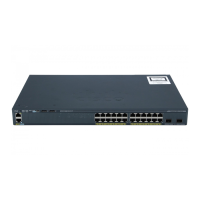CHAPTER
36-1
Catalyst 2960 and 2960-S Switches Software Configuration Guide, Release 15.0(1)SE
OL-26520-01
36
Configuring IPv6 MLD Snooping
You can use Multicast Listener Discovery (MLD) snooping to enable efficient distribution of IP
version 6 (IPv6) multicast data to clients and routers in a switched network on the Catalyst 2960, 2960-S,
or 2960-C switch. Unless otherwise noted, the term switch refers to a standalone switch and to a switch
stack.
Note Stacking is supported only on Catalyst 2960-S switches running the LAN base image.
Note To use IPv6 on a Catalyst 2960 switch, you must configure the dual IPv4 and IPv6 Switch Database
Management (SDM) template on the switch. You select the template by entering the sdm prefer
dual-ipv4-and-ipv6 default global configuration command. This template is not required on a Catalyst
2960-S switch.
For related information, see these chapters:
• For more information about SDM templates, see Chapter 8, “Configuring SDM Templates.”
• For information about IPv6 on the switch, see Chapter 35, “Configuring IPv6 Host Functions.”
Note For complete syntax and usage information for the commands used in this chapter, see the command
reference for this release or the Cisco IOS documentation referenced in the procedures.
This chapter includes these sections:
• “Understanding MLD Snooping” section on page 36-1
• “Configuring IPv6 MLD Snooping” section on page 36-5
• “Displaying MLD Snooping Information” section on page 36-11
Understanding MLD Snooping
In IP version 4 (IPv4), Layer 2 switches can use Internet Group Management Protocol (IGMP) snooping
to limit the flooding of multicast traffic by dynamically configuring Layer 2 interfaces so that multicast
traffic is forwarded to only those interfaces associated with IP multicast devices. In IPv6, MLD snooping
performs a similar function. With MLD snooping, IPv6 multicast data is selectively forwarded to a list
of ports that want to receive the data, instead of being flooded to all ports in a VLAN. This list is
constructed by snooping IPv6 multicast control packets.

